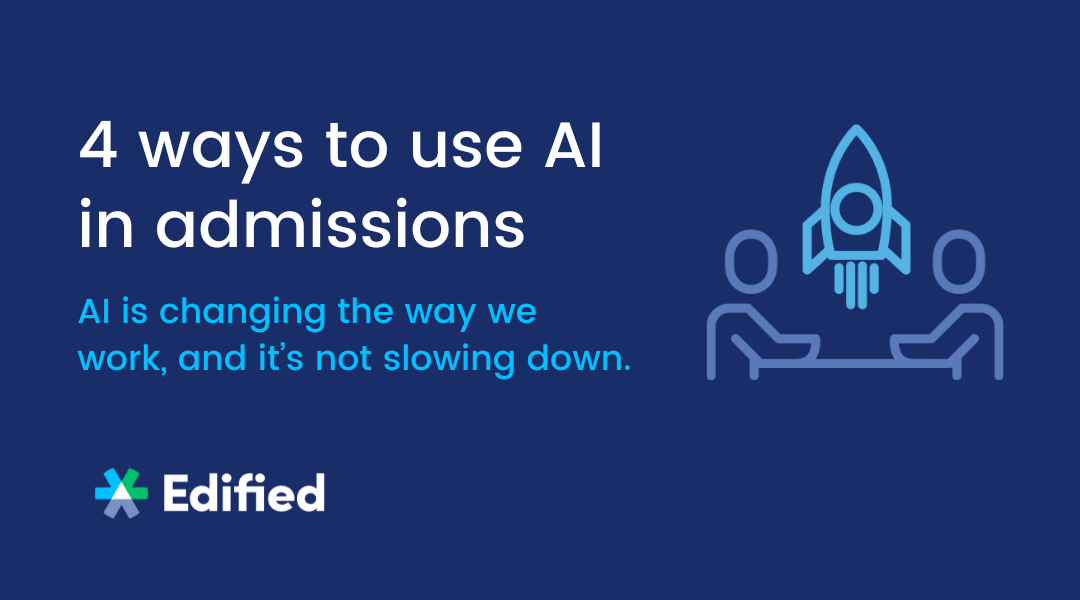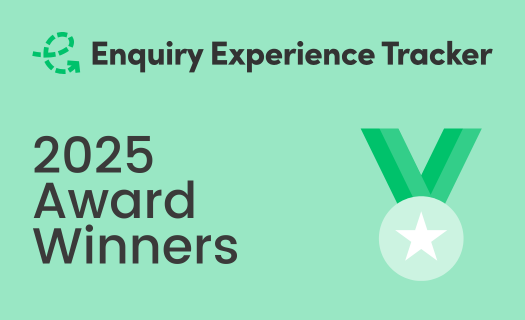4 ways to use AI in admissions
For some, the shift to AI is full of promise and possibility. For others, it brings discomfort, especially when headlines focus on job displacement. But if used wisely, AI has the potential to elevate human work, shifting our roles from reactive and operational to analytical, strategic and impactful.
For those in admissions, now is an exciting time to reposition your work. Let technology help with processing tasks and set your mind towards workflow design, conversion analysis, knowledge management, forecasting, student engagement and stakeholder influence.
So, where do you begin?
💡 Before diving in, it’s important to upskill yourself on ethical and safe use of AI.
While experimenting at home is one thing, your professional context comes with additional responsibilities. Charles Sturt University has published a helpful public framework for staff called S.E.C.U.R.E. to guide decision-making around generative AI use. It’s a good resource to benchmark your own approach.
In short: if your activity doesn’t involve security or ethical concerns, and steers clear of using confidential, private or protected information, then it’s likely safe to experiment. Always check your institution’s policies first though, and involve IT or legal teams where needed.
1. Put free tools to work for quick wins
For teams just starting out with AI or working with limited resources, you can make an impact quickly using free tools (like ChatGPT, Gemini or Microsoft Copilot). Here are some ideas for you to experiment with, build confidence and generate immediate benefits without heavy investment or technical expertise.
📤 Enhance applicant communications
Use generative AI tools to refresh your admissions email templates. Try prompts that ask the tool to:
- make the text more concise and easier to understand
- make the text suitable for readers who are not native English speakers
- improve warmth and align the tone with your brand guidelines
- make the call-to-action clear.
Refine the outputs until you’re satisfied they are accurate and match your brief. Test the new versions with students or agents. If you’re confident in what you’ve produced, scale it across your full suite of templates or even that unwieldy list of offer conditions that often get forgotten in content updates.
📝 Create clear admissions FAQs and summaries
Ask AI tools to turn complex admissions policies and procedures into concise, student-friendly summaries and FAQs. Simply paste your existing documents or web content into the tool, and ask for plain English summaries or FAQs based on common questions. Review and tailor the outputs to make sure they are accurate and fit your institution’s tone. You can even use AI to translate them into other languages (always get them checked for accuracy by a native speaker). Share the results with your enquiry team and consider adding them to your website or applicant portal for easy student access.
2. Buy existing third-party solutions
If your institution is ready to move beyond experimentation, partnering with specialised vendors or adopting sector-specific AI software can deliver targeted efficiencies and improved outcomes with moderate budget and some change management effort.
⚙️Automate handling of incomplete applications
Adopt AI-powered platforms that review applications, validate documents using Optical Character Recognition (OCR) and identify incomplete applications. These systems can also generate personalised follow-ups to prompt applicants to provide missing information before the application is routed to a staff member for processing.
🛡️ Enhance fraud detection
Implement AI solutions that detect fraudulent applications by analysing patterns such as inconsistent fonts, altered images or mismatched information. These tools can significantly reduce the risk of admitting inauthentic applicants.
⏩ Accelerate assessment decisions
Leverage AI to codify your admissions criteria into automated decision-making processes. Back in 2024, INTO University Partnerships reported that their AI-enabled admissions system processes more than 30% of applications within an hour and issues some offers in minutes. Several of our client universities are in the midst of AI-assisted automation pilots, with one tool processing 100 applications concurrently in one minute, with 100% accuracy.
💬 Conduct preliminary interviews
AI-powered interview tools can support initial credibility or Genuine Student checks by providing a consistent and efficient way to assess applicants. These systems can flag potential deepfake attempts, verify identity against official documents and compare spoken English proficiency with submitted test results to identify major discrepancies. They can also guide the conversation to uncover missing information, highlight gaps in an applicant’s story, and generate a clear summary of additional documents or evidence the student needs to provide before the next stage.
💡 As with any technology, AI comes with risks that must be carefully managed.
Make sure your team understands how data is being collected, processed and stored. Think through the steps you'll take to mitigate bias in AI-generated outcomes and how you'll ensure automated decisions are reviewed for fairness and accuracy.
It’s also useful to understand your responsibilities under the EU Artificial Intelligence Act, which covers all people (including prospective students) located in the EU. This legislation considers the use of AI systems to determine access or admission to educational and vocational training institutions as a high-risk activity and subject to some specific compliance requirements. Talk to your IT, legal and risk teams early when introducing AI into your workflows.
While AI is a powerful assistant, it doesn’t replace human expertise. Admissions is about more than matching documents to rules. It’s about the future aspirations of real people, so judgement and context can’t be displaced.
Even if you bring on some great new tools, make sure AI-powered decisions are subject to human review, especially when they impact student outcomes. Run AI and human processes side by side during pilots, track discrepancies, and build in regular audit checkpoints to ensure quality and fairness.
3. Leverage internal tools to deepen data intelligence
For teams with access to robust data infrastructure and analytical skills, harnessing existing internal tools like CRM and BI platforms can enable deeper insights and predictive capabilities that support strategic decision-making and policy refinement.
Your institution likely uses tools like Power BI or Tableau, which now include AI features. Talk to your data team about:
- combining CRM and admissions data to improve forecasting and identify trends in applicant behaviours
- spotting where you’re likely to hit (or miss) enrolment targets
- identifying patterns across agents, schools, cities or qualifications
- building a model that predicts which applicants are most likely to convert
- testing if certain entry criteria or pathways correlate with student outcomes.
More advanced use cases include combining admissions and academic performance data to evaluate the impact of your entry policies on GPA, retention and at-risk student profiles. Better data means better decision-making, especially when managing risk, informing policy adjustments and designing targeted interventions.
💡 Always interpret data with care.
AI models are only as fair and accurate as the data they’re trained on. Historical admissions decisions may reflect biases from past policies, processes or human judgement that unintentionally disadvantaged certain groups. Left unchecked, these biases can be reinforced by AI tools and lead to flawed or unfair recommendations. Always interpret insights in context, involve diverse perspectives when reviewing outcomes and consider whether patterns reflect true student potential or unfair bias within the source data.
4. Go big with a customised solution
If you have the appetite, budget and in-house expertise to innovate, invest in a bespoke AI solution that offers the opportunity to differentiate your institution. Perhaps you can create a highly tailored, innovative admissions experience and support applicants better than ever before.
Take a look at ApplyBoard’s AI assistant, Abbie, that offers personalised guidance to applicants, assisting them through course selection and application processes.
Consider how you could deploy AI agents capable of performing multi-step tasks on behalf of applicants, such as document submission or visa application guidance. These solutions can significantly enhance the applicant journey and your operational efficiency.
Ready to explore?
We’re excited about what AI means for applicant experience, personalisation and scale – and how institutions are already seeing gains from incorporating AI into their work. Technology is evolving all the time, and you may be wondering if your institution is making the most of what’s available and where AI could support improvement.
Perhaps you’re also thinking about the bigger picture and how well your institution is positioned for the future of international admissions and recruitment. Check out the Admissions Navigator, a new self-assessment tool for UK universities, developed by Edified, Flywire and Tribal in collaboration with 18 UK universities. With this tool, you’ll be able to evaluate your international admissions and recruitment capabilities across eight future-focused areas and get some tips on where to concentrate your efforts.
Get in touch
At Edified, we love working with innovators and we love getting under the hood with admissions. If you’re exploring ideas or want help assessing your options, get in touch.

Elissa Newall
Senior Partner
elissa@edified.com.au



